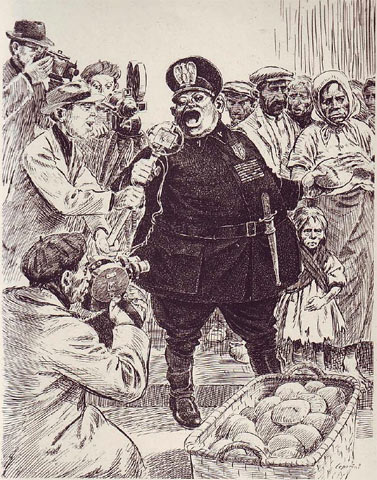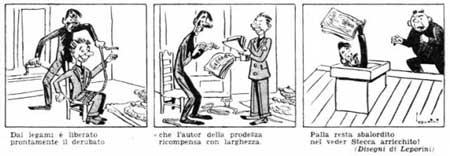'Quando il Goggiam Era in Fiamme'.
Born in Rome, Bernardo Leporini graduated from the Academy of Fine Arts in this city and began his career cooperating with Il Travaso. Subsequently, he began collaborations with Marc'Aurelio, Il Bertoldo en Il Guerin Meschino. Leporini lived in Berlin, Germany, from 1929 to 1936, where he did book illustrations for many publishers and where he was part of the team of the Lustige Blätter. Back in Italy, he drew stories for Argentovivo!, such as 'Quando il Goggiam era in Fiamme...', 'Il Tesoro dei Ghiacci', 'Il Siero del Professor Radius' and the humorous panel 'Palla e Stecca'. He also cooperated on the magazines of the publishing house Mondadori, such as Topolino and Paperino, for which he made adaptations of 'La Regina dei Caraibi', 'Jolanda la Figlia del Corsaor Nero' and 'La Montagna dell'Oro' (script by Federico Pedrocchi).
Anti-fascist cartoon.
During World War II, Leporini was affiliated with the publishing house Alpe and the dailies Avanti!, L'Unità and La Domenica del Corriere. He also made a book with sixty illustrations about the horrors of war. In September 1945, he became the editor of the short-lived comics weekly Dinamite, of which the artistic director was Federico Pedrocchi. The magazine lasted 12 issues, after which it returned in comic book format. For the Urrà newspaper, Leporini then made 'Il Cobra Bianco' in 1947. Around the same time, he was also present in Intrepido with 'La Freccia d'Argento' and 'Il Tenente dei Dragoni'. He also illustrated several albums in the collection Albo dell'Intrepido.
From 1948, Leporini illustrated episodes of 'Maciste' for Edizioni Milano, and drew 'Gengis Khan' for the Albi d'Oro collection of Mondadori. For Bonelli, he made 'Il Piccolo Contrabbandiere' as a supplement of the Collana del Tex series. In 1951, he edited a series of six books called 'Ragazzi in Gamba'. Bernardo Leporini retired in Milan in the 1970s, where he continued to paint. A book with Leporini's anti-fascist drawings, called '20 Anni di Fascismo Visti da Leporini' was published in 1976. Leporini died in the 1990s.
'Palla e Steca'.




